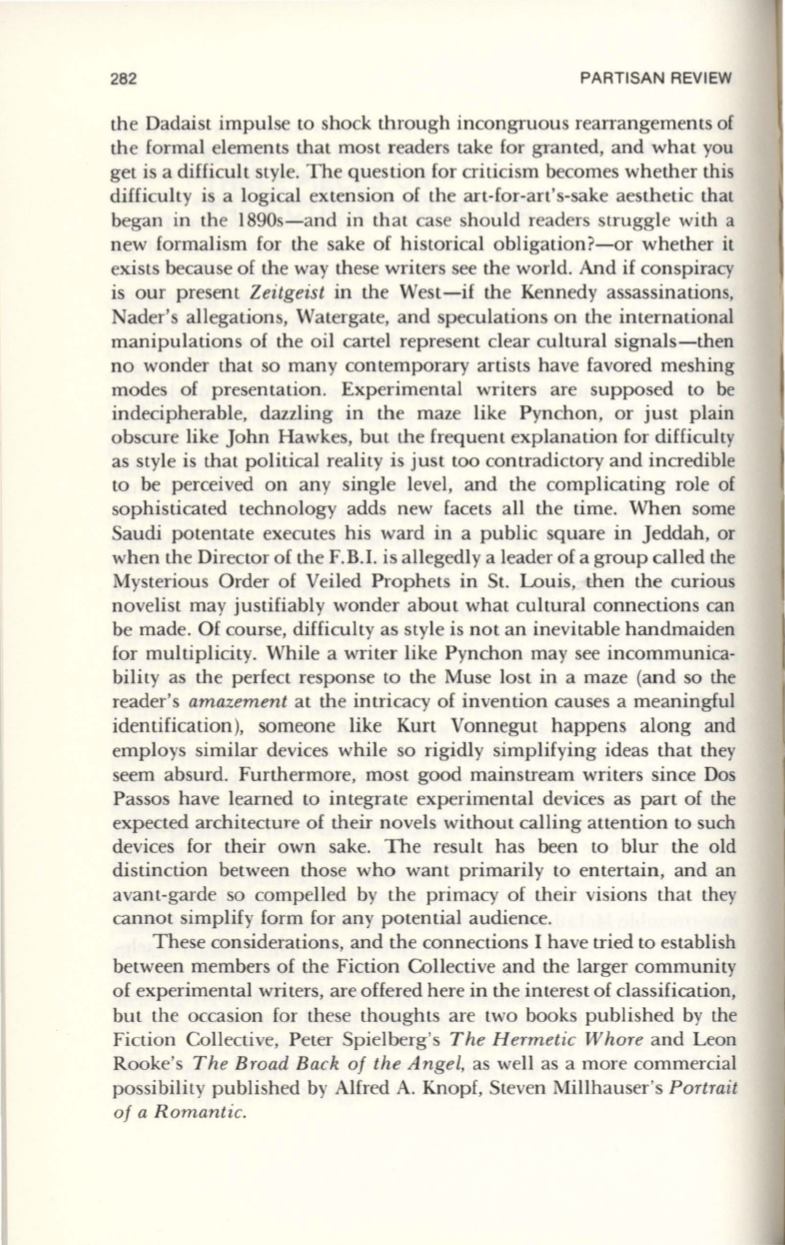
282
PARTISAN REVIEW
the Dadaist impulse to shock through incongruous rearrangements of
the formal elements that most readers take for granted, and what you
get is a difficult style. The question for criticism becomes whether this
difficulty is a logical extension of the art-for-art's-sake aesthetic that
began in the 1890 -and in that ca e should readers struggle with a
new formalism for the sake of historical obligation?-or whether it
exists because of the way these writers see the world. And if conspiracy
is our present
Zeitgeist
in the West-if the Kennedy assassinations,
Nader's allegations, Watergate, and speculations on the international
manipulations of the oil cartel represent clear cultural signals-then
no wonder that so many contemporary artists have favored meshing
modes of presentation. Experimental writers are supposed to be
indecipherable, dazzling in the maze like Pynchon, or just plain
obscure like John Hawkes, but the frequent explanation for difficulty
as style is that political reality is just too contradictory and incredible
to be perceived on any single level, and the complicating role of
sophisticated technology adds new facets all the time. When some
Saudi potentate executes his ward in a public square in Jeddah, or
when the Director of the F.B.I. is allegedly a leader of a group called the
Mysterious Order of Veiled Prophets in St. Louis, then the curious
novelist may justifiably wonder about what cultural connections can
be made. Of course, difficulty as style is not an inevitable handmaiden
for multiplicity. While a writer like Pynchon may see incommunica–
bility as the perfect response to the Muse lost in a maze (and so the
reader's
amazement
at the intricacy of invention causes a meaningful
identification), someone like Kurt Vonnegut happens along and
employs similar devices while so rigidly simplifying ideas that they
seem absurd. Furthermore, most good mainstream writers since Dos
Passos have learned
to
integrate experimental devices as part of the
expected architecture of their novels without calling attention to such
devices for their own sake. The result has been to blur the old
distinction between those who want primarily to entertain, and an
avant-garde so compelled by the primacy of their visions that they
cannot simplify form for any potential audience.
These considerations, and the connections I have tried to establish
between members of the Fiction Collective and the larger community
of experimental writers, are offered here in the interest of classification,
but the occasion for these thoughts are two books published by the
Fiction Collective, Peter Spielberg's
The H ermetic Whore
and Leon
Rooke's
The Broad Back of the Angel,
as well as a more commercial
possibility published by Alfred A. Knopf, Steven Millhauser's
Portrait
of a Romantic.


